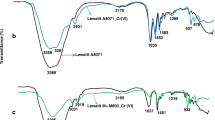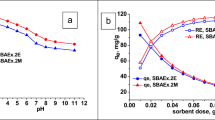Abstract
Ion exchange processes are effective for the removal of arsenic (As) from drinking water. However, the As uptake capacity of ion exchange resins is affected by the presence of other anions such as sulphates and nitrates. As these ions are typically found in groundwater, the design of ion exchange process aimed at removing As from groundwater may be affected by their presence. Therefore, to properly design an ion exchange process for As removal, it is important to characterise the ion exchange equilibria of As in solution in the presence of competing anions. This paper was aimed at obtaining a deeper understanding of the binary equilibria of As(V)Cl− and SO4 2−/Cl− and of the ternary equilibria of As(V)/SO4 2−/Cl−. To this purpose, a series of batch tests were carried out at different values of the total solution normality. These data were combined with those obtained through continuous flow column tests performed to collect equilibrium data over the entire ionic fraction domain. The equilibrium data were then described using two different models based on the assumption of ideal behaviour of both the liquid and the adsorbed phases: in the first model the resin was considered to have only one type of binding-sites, where two types of binding sites were assumed by the second model, named double-selectivity model. Among these two models, the latter provided the best fitting of binary equilibrium data for both As chlorides and sulphate chlorides systems. However, the same model was unable to fit the experimental data of As in the ternary system As(V)/SO4 2−/Cl− with a satisfactory agreement probably due to the presence of non-ideality which the model did not account for.




Similar content being viewed by others
Abbreviations
- As:
-
Arsenic
- As(V):
-
Pentavalent arsenic
- As(III):
-
Trivalent arsenic
- DVB:
-
Divinylbenzene
- IE:
-
Ion exchange
- C i :
-
Concentration of ith ion in solution phase (milliequivalents per litre)
- K :
-
Thermodynamic equilibrium constant
- K j :
-
Thermodynamic equilibrium constant for functional groups of type j
- K j, i :
-
Thermodynamic equilibrium constant between ion i and reference counterion for functional groups of type j
- \( \overline{K} \) :
-
Average value of equilibrium constant distribution
- N :
-
Total concentration or normality of the solution phase (milliequivalents per litre)
- N f :
-
Number of types of functional groups
- r j :
-
Fraction of functional groups of type j
- q i :
-
Concentration of ith ion in the resin phase (milliequivalents per gramme)
- q j, i :
-
Concentration of ith ion on functional groups of type j (milliequivalents per gramme)
- q 0 :
-
Total ion exchange capacity (milliequivalents per gramme)
- q 0, j :
-
Ion exchange capacity of functional groups of type j (milliequivalents per gramme)
- X i :
-
Ionic fraction of ith ion in the solution phase
- Y i :
-
Ionic fraction of ith ion in the resin phase
- Y j, i :
-
Ionic fraction of ith ion in the resin phase on functional groups of type j
- Q :
-
Separation factor
References
American Public Health Association/American Water Works Association/Water Environment Federation. (1998). Standard Methods for the Examination of Water and Wastewater (19th ed.). Washington, DC: American Public Health Association/American Water Works Association/Water Environment Federation.
Awual, M. R., & Jyo, A. (2009). Rapid column-mode removal of arsenate from water by crosslinked poly(allylamine) resin. Water Research, 43, 1229–1236.
Awual, M. R., Urata, S., Jyo, A., Tamada, M., & Katakai, A. (2008). Arsenate removal from water by a weak-base anion exchange fibrous adsorbent. Water Research, 42, 689–696.
Awual, M. R., Shenashen, M. A., Yaita, T., Shiwaku, H., & Jyo, A. (2012). Efficient arsenic(V) removal from water by ligand exchange fibrous adsorbent. Water Research, 46, 5541–5550.
Baciocchi, R., Chiavola, A., & Gavasci, R. (2005). Ion exchange equilibria of arsenic in the presence of high sulphate and nitrate concentrations. Water Science and Technology-Water Supply, 5(5), 67–74.
Bissen, M., Veillard Baron, M. M., Shindelin, A. J., & Frimmel, F. H. (2001). TiO2-catalyzed photooxidation of arsenite to arsenate in aqueous samples. Chemosphere, 44, 751–757.
Bricio, O., Coca, J., & Sastre, H. (1993). Equilibrium isotherms for Amberlite 200 in concentrated solutions. In 6th Mediterranean Congress on Chemical Engineering, Expoquimia '93, P-1.1.03.
Bricio, O. J., Coca, J., & Sastre, H. (1998). Modelling equilibrium isotherms for styrene-divinylbenzene ion exchange resins. Chemical Engineering Science, 53(7), 1465–1467.
Choong, T. S. Y., Chuah, T. G., Robiah, Y., Koay, F. L. G., & Azni, I. (2007). Arsenic toxicity, health hazards and removal techniques from water: an overview. Desalination, 217, 139–166.
Cumbal, L., & SenGupta, A. K. (2005). Arsenic removal using polymer-supported hydrated iron(III) oxide nanoparticles: role of Donnan membrane effect. Environmental Science and Technology, 39, 6508–6515.
Ghurye, G. L., Clifford, D. A., & Tripp, A. R. (1999). Combined arsenic and nitrate removal by ion exchange. Journal of American Water Works Association, 91(10), 85–96.
Helferrich, F. (1962). Ion Exchange. New York (USA): McGraw-Hill, Inc.
Jones, I. L., & Carta, G. (1993). Ion exchange of amino acids and dipeptides on cation resins with varying degree of cross-linking. 1. Equilibrium. Industrial & Engineering Chemistry Research, 32, 107–117.
Kim, K., & Benjamin, M. M. (2004). Modeling a novel ion exchange for arsenic and nitrate removal. Water Research, 38, 2053–2062.
Melis, S., Cao, G., & Morbidelli, M. (1995). A new model for the simulation of ion exchange equilibria. Industrial & Engineering Chemistry Research, 34, 3916–3924.
Melis, S., Markos, J., Cao, G., & Morbidellli, M. (1996). Multicomponent equilibria on ion-exchange resins. Fluid Phase Equilibria, 117, 281–288.
Myers, A. L., & Byington, S. (1986). Thermodynamics of ion exchange: Prediction of multicomponent equilibria from binary data (In A. E. Rodrigues (Ed.), Ion Exchange Science and Technology (pp 119–145). NATO ASI Series E N° 107). Dordrecht: The Netherlands.
Ncibi, M. C. (2008). Applicability of some statistical tools to predict optimum adsorption isotherm after linear and non-linear regression analysis. Journal of Hazardous Materials, 153, 207–212.
Pepe, F., Caputo, D., & Colella, C. (2003). The double selectivity model for the description of ion-exchange equilibria in zeolites. Industrial &Engineering Chemistry Research, 42, 1093–1097.
Sharma, V. K., & Sohn, M. (2009). Aquatic arsenic: toxicity, speciation, transformations, and remediation. Environment International, 35, 743–759.
Smedley, P. L., & Kinniburgh, D. G. (2002). A review of the source, behaviour and distribution of arsenic in natural waters. Applied Geochemistry, 17, 517–568.
United States Environmental Protection Agency (2003) Arsenic Treatment Technology Evaluation Handbook for Small Systems. Office of Water (4606 M) EPA 816-R-03-014.
Viaraghavan, T., Subramanian, K. S., & Aruldoss, J. A. (1999). Arsenic in drinking water problems and solutions. Water Science Technology, 40(2), 69–76.
Wheaton, R. M., & Bauman, W. C. (1951). Properties of strongly basic anion exchange resins. Industrial and Engineering Chemistry, 43(5), 1088–1093.
Author information
Authors and Affiliations
Corresponding author
Rights and permissions
About this article
Cite this article
Chiavola, A., Baciocchi, R. & D’Amato, E. Application of a Two-Site Ideal Model for the Prediction of As–SO4–Cl Ion Exchange Equilibria. Water Air Soil Pollut 225, 1810 (2014). https://doi.org/10.1007/s11270-013-1810-z
Received:
Accepted:
Published:
DOI: https://doi.org/10.1007/s11270-013-1810-z




